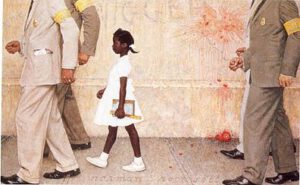
Before watching the film Ruby Bridges I knew the name and that the little girl inspired the famous Norman Rockwell painting “The Problem We All Live With.” The title of the artist’s painting is from the perspective of a white man: this movie is from the perspective of the little girl who suffered and persevered because of the “problem.” I’m sure James Baldwin would have corrected Rockwell and declared that it is the White man, not “the Negro,” who is the problem. I am currently reading Baldwin’s 660 page PRICE OF THE TICKET: Collected Nonfiction 1948-1985, and find that he makes this charge over and over again. Were it not for the deeply embedded hatred of Whites who need someone to look down upon to uphold their own worth, there would be no “Negro problem” –this he tried to convince his countrymen throughout his prophetic writing career.
Secondly, I had read numerous articles by the psychiatrist Robert Coles, but had not realized he had been so involved with the story of the brave little girl who faced the hostile crowds every school day. Those four U.S. Marshals before and behind her, whom the artist only partially shows because he wanted us to focus on the vulnerable young girl, were absolutely necessary. The so-called adults gathered by the school steps were so full of hate that they would have lynched her but for them–look what a similar group of racists did to those little girls at a Birmingham church three years later! Coles had devoted his career to the treatment of children under stress, and he rightly saw at the beginning of her trials that she might benefit from his help. He does indeed help her and her parents cope, but the movie shows that the little girl, through the faith she shared with her mother, taught him as well–and he was humble enough to acknowledge this.
Thirdly, The movie demonstrates again the wisdom of the African proverb “It takes a village to raise a child.” Ruby’s mother and her continually reminding her that God loves her and that Jesus had also faced a mob sustains her–at times as the girl mounts the steps amidst all the words of hate she hears the voices of her mother and father encouraging her. In addition is the church which the family attends where the pastor preaches a social gospel, in keeping with so many other Black pastors who have sustained their members through the years of slavery, Jim Crow, and the Civil Rights era. Although it is the White mob that the filmmakers focus on spewing their bile at the little girl, there were also Blacks who came out to offer support–we see them at least twice. I wish the camera had pulled back enough so that we could have seen where they stood in relation to the mob. From my reading I know also that many men in Ruby’s neighborhood stood watch through the night to make sure Whites did come in and attack her home. The NAACP provided financial support, especially needed after Abon was fired from his job. This, plus the neighbors sharing food, we see in the film. It does indeed take a village to raise a child!
Oh yes, one more thing. While Googling the name of the painting, I came upon the YouTube video in which we are given the work’s background. Joining the curator is the adult Ruby Bridges herself, commenting upon it. Click here to see this delightful almost 11 minute video.

